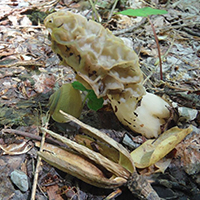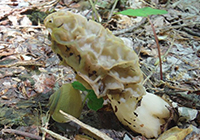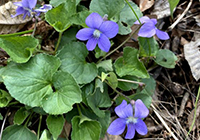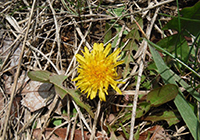Morel mushrooms are popping up all over southern Indiana this week! Over the next two or three weeks the outbreak will work its way north across Indiana as many enjoy both hunting and eating the most prized member of the Morchella, or sponge, genus of mushroom that you often see in stores for $50-60/lb. Considered one of the absolute best edible fungi, dozens of recipes include stuffed, sauteed, and baked preparation.
The morel can also be frozen for later use. Do not freeze them raw. Clean and then boil whole for 5 minutes. To sauté, slice and soak a pound of mushrooms in lightly salted water for one to two minutes, then sauté for five minutes in two tablespoons butter to help them maintain their flavor and texture. Pack mushrooms and liquid tightly into freezer bags. Mark the date on the bags. Mushrooms will keep for a year in the freezer. Enjoy their meaty, juicy, nutty flavor into winter! This is just one of many edible fungi in the area.
It's spring! Here are some of the other wonderful edibles that may be popping up in your yard or in a nearby wooded area that you can enjoy:
- Violets (viola sororia sororia, v. papilionacea)- while both leaves and flowers of the common blue violet are edible, most people stick to the flowers to sprinkle as a raw garnish on a spring salad, or to flavor vinegar, tea, or syrup. Candied violets are another spring treat. Violets contain vitamin C and vitamin A. The taste is mostly just like other greens, but they also add in a wonderful perfume fragrance. Harvest early to mid-spring.
- Dandelion (Taraxacum officinale Weber)– We are probably most familiar with dandelion greens. Known as one of the first greens of spring, pioneers used them to revive their bodily systems from winter-accumulated toxins and vitamin deficiencies. Herb doctors gave the pressed juice of dandelion root to patients as a tonic. Now most people consider dandelion an annoying weed that needs to be irradicated from the yard. Leaves and roots are rich in vitamin A and C. If you are sensitive to latex be careful handling the plant. Juice from inside the hollow stem may cause contact dermatitis.
Do not pick old leaves from flowering plants in the yard. According to author, Euell Gibbons, the best greens are the just newly emerging reddish leaves you may find in the woods. He recommends digging out the root and all. Clean thoroughly, peel the root, slice crosswise, boil in two waters, with a pinch of soda added to the first water. Sauté with a little salt, pepper, and butter.
Dandelion roots are also well-known roasted as a coffee substitute. Newly forming, closed blossom material found close to the plant’s crown, before the stalk forms, are considered an edible vegetable when cooked in boiling water for about three minutes. Dandelion flowers have been used by people for centuries to flavor wine when paired with ginger root, orange, and lemon.
- Water Cress (Nasturtium officinale R. “Br.) – found growing wild all over the United States, this member of the Mustard Family grows readily in cool, running water. This pungent and medicinal plant is rich in vitamins and minerals. Be careful if you are picking from the wild that the stream bed water is not polluted. Plants readily pick up stream contaminants. Just in case you have this question, the garden nasturtium (Tropaeoleum) is not the same plant but is also edible. Water Cress is used as a fresh salad green and an addition to light tea sandwiches. Greens can also be boiled or, to save fresh vitamins, sauté lightly in a little oil with fresh ginger. Greens can also be added to soup to enhance flavor.
When wildcrafting, here are a few rules that help.
- Make sure that you have properly identified the plant prior to ingesting and be aware of any allergic responses. This is especially important with fungi, but it also applies to other wild edibles that sometimes have toxic look-alikes.
- Conserve and share. Use a mesh bag when gathering mushrooms so that the spores can fall to the ground as you walk to replenish the supply. Never pick all the plants at a picking site. Leave some to grow new plants.
- Don’t pick near a road or other site where there might be potential contamination. Exhaust fumes heavily pollute roadside plants, and locations near some manufacturing facilities putting out toxic waste chemicals can contaminate nearby land. Think about your yard as well. Are you or a neighbor using inorganic fertilizer or spraying for bugs? Just use good sense in choosing a gathering site.
- Investigate the plant you intend to gather. One species may be preferrable over another. There are many ways to find out more. One very helpful group that you can find on Meta (Facebook) is the Indiana Native Plant Society (INPS). Just post a photo of the plant in question, and you may get many helpful answers. Another helpful resource is Plant Snap, an app you can place in your mobile phone. Just snap a photo of the plant and get an answer about what it is. Google is another great resource for quick information on plants.
- Follow directions in preparation of wild foods. Experts such as Gibbons and others speak from long experience. Sometimes bitter elements of foods need to be removed in preparation to make them good eating. Pay attention to what those that eat wild food on a regular basis have to say.
You may also wish to check for any medicinal information on the wild food, and there can be contraindications to a specific medicine you take. Most wild food grown in the USA has been thoroughly researched by the U.S. Department of Agriculture (USDA). Top botanist Dr. James Duke created an entire database of the world’s medicinal plants. His book The Green Pharmacy Herbal Handbook (St. Martin’s Paperbacks) is a handy companion, as is Peterson’s Field Guide to Eastern/Central Medicinal Plants by Steven Foster/James A. Duke.





